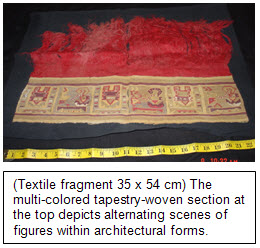
Quick Links
News Releases
February 11, 2009
ICE and CBP return 334 pre-Columbian artifacts to Peruvian government
 LAREDO, Texas - Officials from U.S. Immigration and Customs Enforcement (ICE) and U.S. Customs and Border Protection (CBP) on Wednesday returned to the Peruvian government 334 pre-Columbian artifacts that were seized in 2007 following an ICE-led investigation.
LAREDO, Texas - Officials from U.S. Immigration and Customs Enforcement (ICE) and U.S. Customs and Border Protection (CBP) on Wednesday returned to the Peruvian government 334 pre-Columbian artifacts that were seized in 2007 following an ICE-led investigation.
The investigation began when ICE agents in Laredo received information from ICE's National Cyber Crimes Center about the alleged illegal sale in the Laredo area of Peruvian artifacts by a seller, Jorge Ernesto Lanas-Ugaz, 44.
On March 1, 2007, a CBP officer at Houston's Bush Intercontinental Airport referred Lanas-Ugaz, who had just arrived from Lima, Peru, for a secondary examination. During CBP's inspection of Lanas-Ugaz's luggage, officers noted several items in bubble wrap, including a clay figurine of a man in a chair and clay bowls. CBP officers held the five items as possible pre-Columbian Peruvian artifacts, which are protected under the Convention on Cultural Property Implementation Act. CBP contacted ICE, which had the artifacts evaluated by archeologists from the American Museum of Natural History. Museum archaeologists confirmed that the items are authentic pre-Columbian and have significant cultural value.
Four days later, ICE, CBP and Laredo Police Department officers executed a federal search warrant at Lanas-Ugaz's home in Laredo. They discovered many additional authentic artifacts, which included: textiles, ceramic figures, wood sculptures, and metal and stone art. All the items had been illegally exported from Peru into the United States. Lanas-Ugaz, a U.S. citizen, was arrested at his home without incident.
This is one of the largest seizures of Peruvian pre-Columbian artifacts into the south Texas area. Peru is one of the signatories to a 1970 General Conference of the United Nations Educational, Scientific and Cultural Organization (UNESCO) Convention on the Means of Prohibiting and Preventing the Illicit Import, Export and Transfer of Ownership of Cultural Property. Through the Convention on Cultural Property Implementation Act, the United States entered into a cultural property agreement with the Peruvian government to help protect archaeological and ethnological materials through import controls.
 All the seized artifacts were further examined and authenticated by research scientists from the Smithsonian Institution's National Museum of Natural History, Latin American Archaeology Program.
All the seized artifacts were further examined and authenticated by research scientists from the Smithsonian Institution's National Museum of Natural History, Latin American Archaeology Program.
"The 300-plus artifacts we've recovered aren't gift-shop souvenirs," said Jerry Robinette, special agent in charge of ICE Office of Investigations in San Antonio. "They are a significant part of the cultural history of Peru, dating back centuries. No one should profit from smuggled antiquities that are part of our world's history that can never be replaced. This repatriation shows the success of cooperative efforts among foreign governments and U.S. federal, state and local law enforcement authorities."
"I would like to commend the hard work of CBP officers and our Office of Fines, Penalties and Forfeitures in Laredo to detect and detain some of the artifacts in Houston and work together with our counterparts in ICE and consular officials to enable forfeiture and release of these priceless artifacts to their rightful home in Peru," said Leticia Moran, Director, Field Operations, CBP Laredo Field Office.
"The Peruvian government views with high regard the two years of diligent work invested in recovering these World Cultural Heritage in the frame of the Memorandum of Understanding between Peru and the U.S. that ban the importation of any archaeological material from Peru and that has been recently extended for five more years," said Carlos R. Polo Castañeda, Consul General of Peru in Houston. "We would like to thank the authorities of ICE and CBP for their continuous support and professional work as well as for the recoveries of these priceless Peruvian treasures."
Lanas-Ugaz pleaded guilty May 16, 2007, to one count of knowingly and fraudulently importing into the United States merchandise that is against the law to sell, and receiving stolen goods. On Sept. 13, 2007, he was sentenced to three years probation and a $2,000 fine; he also paid $100 to a crime victims' fund.
This case was prosecuted by the U.S. Attorney's Office, Southern District of Texas.
CBP Field Operations' Office of Fines, Penalties and Forfeitures has worked diligently with CBP officers, CBP Office of Chief Counsel and ICE special agents, archaeologists and consular officials to authenticate, prepare for safe transport, and appraise the 334 pieces seized in the two enforcement actions as pre-Columbian Peruvian artifacts. The final step is the processing of documentation to enable repatriation of the artifacts to Peru.
-- ICE --

